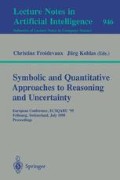Abstract
In this paper we consider action scenarios where actions with default effects are permitted. We present one of the possible preferential strategies applicable for reasoning about such scenarios. This method, intuitively motivated, is provided in terms of circumscription. We adopt the occlusion concept introduced by Sandewall. The analysis is based on the standard two-sorted FOPC with temporal terms and discrete time.
This work was supported by the ESPRIT Basic Research Action No. 6156-DRUMS II.
Preview
Unable to display preview. Download preview PDF.
References
A. Baker: Nonmonotonic reasoning in the framework of situation calculus, Artificial Intelligence, 49, pp. 5–23, 1991.
P. Doherty: Reasoning about action and change using occlusion, in Proc. 11th ECAI-94, 1994, pp. 401–405.
B. Dunin-Keplicz, A. Radzikowska: Epistemic Approach to Reasoning about Action with Typical Effects, in Proc. ECSQUARU-95, 1995.
D. W. Etherington, J. M. Crawford: Formalizing reasoning about change: A qualitative reasoning approach, in Proc. 10th AAAI, San Jose, CA, 1994.
N. Kartha: Two counterexamples related to Baker's approach to the frame problem, Artificial Intelligence, 69, pp. 379–391, 1994.
J. McCarthy, P. J. Hayes: Some philosophical problems from the standpoint of artificial intelligence, in: B. Meltzer and D. Michie, eds., Machine Intelligence 4 (American Elsevier, New York, 1969), pp. 463–502.
E. Sandewall: Features and fluents: A systematic approach to the representation of knowledge about dynamical systems, Technical report LITH-IDA, Linköping University, Sweden, 1994.
Author information
Authors and Affiliations
Editor information
Rights and permissions
Copyright information
© 1995 Springer-Verlag Berlin Heidelberg
About this paper
Cite this paper
Radzikowska, A. (1995). Circumscribing features and fluents: Reasoning about action with default effects. In: Froidevaux, C., Kohlas, J. (eds) Symbolic and Quantitative Approaches to Reasoning and Uncertainty. ECSQARU 1995. Lecture Notes in Computer Science, vol 946. Springer, Berlin, Heidelberg. https://doi.org/10.1007/3-540-60112-0_40
Download citation
DOI: https://doi.org/10.1007/3-540-60112-0_40
Published:
Publisher Name: Springer, Berlin, Heidelberg
Print ISBN: 978-3-540-60112-8
Online ISBN: 978-3-540-49438-6
eBook Packages: Springer Book Archive

